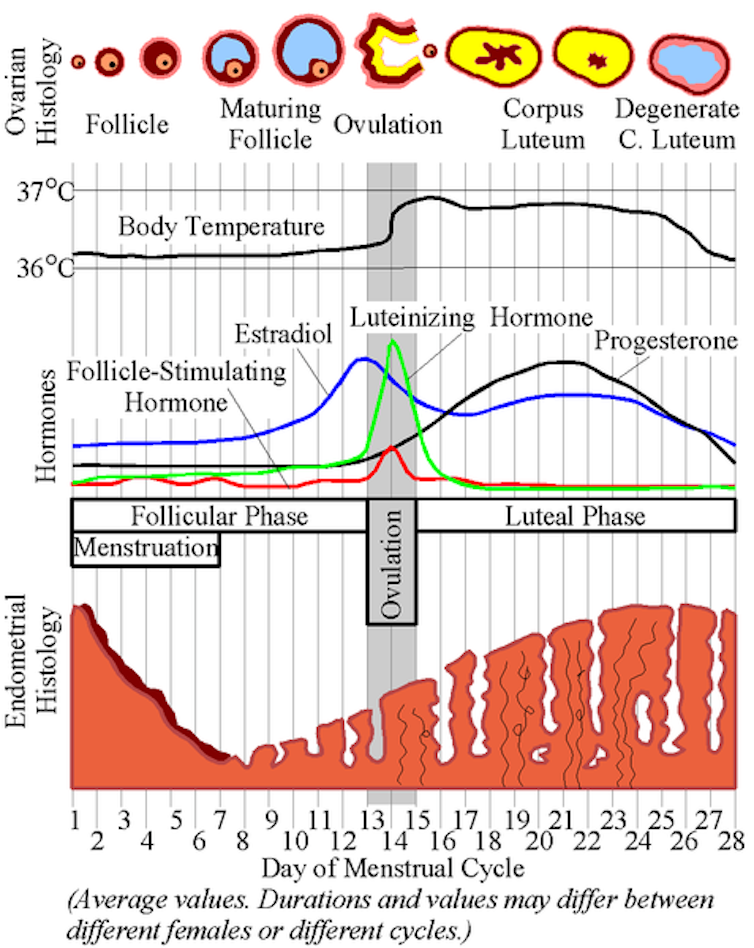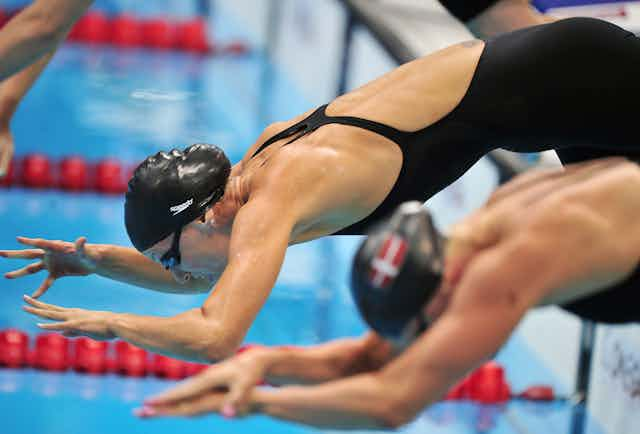For some female athletes, “counting the days” to their Olympic event may have a double meaning. These Olympians may be worried about “what time of the month” it is going to be when they are expected to deliver their best sporting performance ever.
Most female athletes will be exposed to changes in their female hormone levels throughout the Olympics. The two main ones, oestrogen and progesterone, will fluctuate as a result of the menstrual cycle or oral contraceptive use. These hormone changes have many effects outside of the reproductive system and may influence exercise performance.
Even though this may not be the case for all athletes, as high training load is often linked with menstrual irregularities, these hormone fluctuations may affect the performance of female Olympians.
Of course performance at the Olympics will be influenced by many other factors, but we’ll focus here on the effects of female hormones on exercise performance, in particular on muscle strength, aerobic performance and endurance performance.
Muscle strength
Research with large hormone changes, such as during menopause and hormone replacement therapy, has shown that oestrogen has a strengthening effect on muscle. Female athletes may be stronger during the oestrogen peak of the menstrual cycle, which occurs around nine-to-13 days after the onset of bleeding.
Some older research findings have supported this suggestion, but unfortunately they did not actually measure oestrogen levels. Therefore it is unclear if the higher strength happened at the same time as the high oestrogen.

Our research did measure hormone levels and we showed no changes in muscle strength and fatigue over the menstrual cycle.
Only a few studies have investigated the effect of oral contraceptives on muscle strength and they also suggest there’s no change in strength during an oral contraceptive cycle. So it seems that the female athletes participating in strength specific sports may not need to worry about their female hormones as they count down towards their Olympic event.
Aerobic performance
An athlete’s aerobic exercise performance is influenced by their maximal oxygen consumption (VO2max), substrate metabolism (the fuel used for energy production in the body) and ventilation (breathing).
Progesterone increases the amount of air we breathe and menstrual cycle studies have shown an increase in ventilation during the second half of the menstrual cycle (luteal phase), when progesterone is high. Though at higher exercise intensities, those at which most Olympians will be competing, no change in ventilation has been found over the menstrual cycle.

For substrate metabolism, oestrogen is linked with increased use of fat as a fuel and less carbohydrate use, while progesterone fights these effects. It’s unclear exactly what effects the hormone fluctuations during the menstrual and oral contraceptive cycle have on substrate metabolism.
Most menstrual cycle research has shown that VO2max does not change throughout the menstrual cycle, so it seems aerobic performance is not influenced by the menstrual hormone changes. Again not much research has looked at the effects of oral contraceptives on aerobic performance and more research is needed in this area.
For the London Olympians in aerobic sporting events, this means that those with menstrual cycles may be fine to stop worrying about “the time of the month”, while not much information is available for athletes on oral contraceptives.
Endurance performance
For endurance performance, such as during the marathon or triathlon, not only substrate metabolism and ventilation are important, as temperature regulation also plays an important role.
Progesterone increases body temperature, so during the luteal phase body temperature is higher than during the first phase. This higher temperature may have a negative effect on endurance performance, especially in a hot and humid environment. Luckily it is not very likely to be especially hot and humid in London, but female athletes may still be at a disadvantage in the second half of their menstrual cycle.
For athletes using oral contraceptives it is again unclear how their endurance performance may be influenced by hormone changes.
Don’t worry, be happy
It seems that female athletes in strength-specific sports may not need to worry too much about counting the days of their menstrual or oral contraceptive cycle.
For female athletes in aerobic and endurance events the picture is not that clear. Ventilation, substrate metabolism and temperature regulation are influenced by female hormones, but the effect on exercise performance remains unclear.
It’s perfectly possible that, with further research, future female athletes may be able to take advantage of their female hormone changes to improve their Olympic performance.

